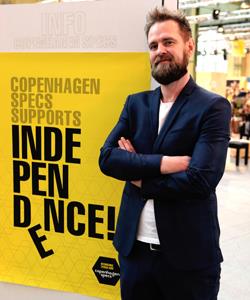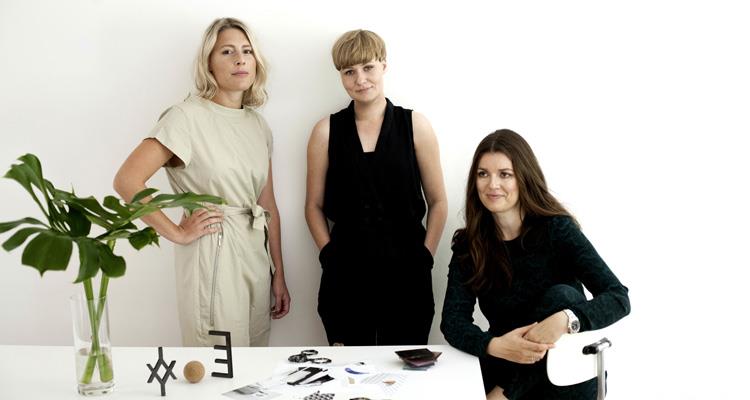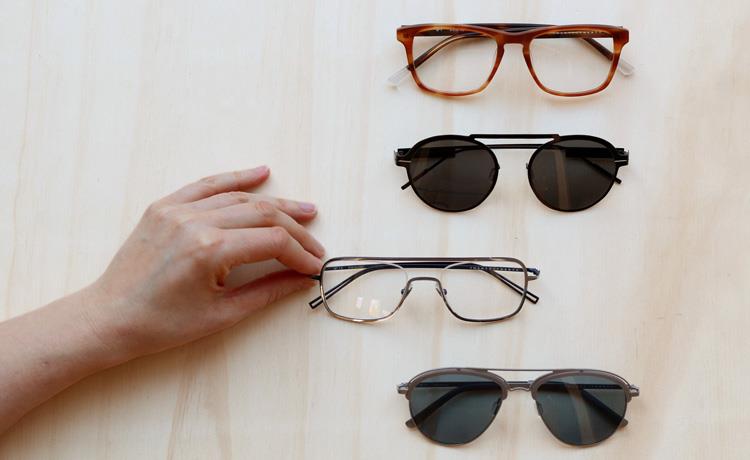Mammoth trade shows like Silmo, Mido and even opti Munich, can be intimidating places. If you are on any sort of schedule, fitting in appointments is difficult enough and time to simply browse is often at a premium. But what is the alternative?
In recent years, several smaller, localised trade shows have come to the fore. One of the most successful has been Copenhagen Specs, with the 2017 edition being its fourth instalment.
This year’s event came the weekend after Mido and while some, mainly exhibitors, would question the timing, it showed the yin and the yang of trade show environments. Specs was relaxed and intimate, with no intimidating stands and limited artificial light. Instead, shelf-scheme stands are created from oriented strand boards and the large windows of Copenhagen’s trendy and industrial Locomotive Venue.

Gammelmark’s interest in optics increased when he began working for Danish optical magazine, Optica, selling advertising. ‘From going to shows like Silmo and Mido, and talking to eyewear brands, I developed a love for eyewear and wanted to create something, but I didn’t want to simply copy what other events do, so I had to think of a concept, which in my mind was wood,’ he explains.
Uniform stands mean there is none of the one-upmanship between companies and none of the closed off stands that do not facilitate browsing. Instead, the wooden walls are only used for branding
It started out with 35 exhibitors and now there are 87, with an additional 31 on the waiting list. Gammelmark says each of the exhibitors is vetted for suitability, primarily based around its independent status. ‘This means there is no Luxottica and no Safilo, and there never will be, because the show supports independent brands and opticians,’ he says.
And he is true to his word. ‘Copenhagen Specs supports independence,’ billboards around the show were not operating on a subliminal level with the use of a dropped e in independence. It was the first-time Copenhagen Specs has done something like that and is a sign of its growing stature.
Considering this selection criteria, Optician asked about the presence of Essilor at this year’s event. ‘They booked their stand before the merger took place. I told them to enjoy the show because it would be the last time they would be allowed to exhibit should the merger be approved,’ says Gammelmark confidently. ‘The money would be nice, but I want to stick to the original principles of the show.’
What is different from other show organisers is that Gammelmark takes a special interest in the exhibitor. Not an account management role, but an investigative one. Exhibitors must pitch their brand story and explain their manufacturing, materials and design process. While this may sound like a superfluous process for an eyewear trade exhibition, it does mean that the standard of product on offer from exhibitors is consistently high and visitors can be more hopeful their trips will be worthwhile.

The inaugural year was very much a litmus test of whether optical professionals and indeed exhibitors, wanted to return. ‘Exhibitors continue to return because it’s a cosy show and has a good atmosphere,’ says Gammelmark. ‘There is only one type of music playing here from our house DJ Katrine Riggs, which helps the ambiance, but most importantly, the exhibitors have more time to spend with their customers, which is good for everybody.’
With four years under its belt and a substantial waiting list of exhibitors, where does Gammelmark see the show in future? ‘I’m not really thinking about expanding. I’m very satisfied with how the show runs now. There could be a few tweaks here and there, but I’m confident that this is the right concept and direction for the show.
‘With regards to the waiting list, I look at it like this: If you have two nightclubs, one with a long line and the other with nobody outside, which one do you want to go in?’
The show’s event programme is also markedly different from others. Rather than a simple guide of exhibitors, the magazine includes articles on marketing and exhibition best practices, along with profiles on some of the brands at the show. It has been a long time since this writer kept a show guide, but the Copenhagen Specs one is sitting on my desk. Once more, the concept of a well-produced show guide might not seem like a lot, but it is just one part of a wider commitment to making sure visitors have had a fun and exciting trade show.
Brand building
The layout of the show guide was undertaken by Twenty Twenty Studio, a young Danish company for which design is just a small part of its business. Twenty Twenty is a full-service agency for the conceptualisation and manufacturing of private eyewear brands.

The Twenty Twenty founders
This is not a run-of-the-mill private label affair where a practice name will be written on the inside of a basic ‘off the shelf’ frame. The company works with individuals to build an entire brand from the ground up.
The first step of the process is a consultation with the three founders, eyewear designer Matilda Sunden Ringner, art director Anne Marie Herold and project manager Katrine Helt Schaarup, who collectively have been working in the eyewear industry for more than 15 years. During this consultation, Twenty Twenty will get to know the customer and what they are hoping to achieve. Here they will drill into the intentions of the customer and find out their stories, ideas and where they envisage the price point of the finished product. ‘We also ask the clients a lot of questions about their end consumers, because they have an impact on the nature of the brand,’ says Herold.

A small selection of Twenty Twenty sample frames
Depending on the design and material specifications, the company has a network of factories around Europe and beyond, which can be called on should their area of expertise be needed within a collection. ‘The location of manufacturing will also depend heavily on the story the brand is trying to tell,’ says Sunden Ringner. ‘We focus very much on the product and make sure it is consistent with the customer-specified brand values,’ she adds. ‘But beyond that, the visual identity and universe around the product is incredibly important,’ says Herold.

Twenty Twenty works with all materials when creating customer brands
Beyond the frame, the company will develop and consider how the frames would look in editorial photoshoots, the best media to be seen in and even working out how accessories will be branded and styled.
When it comes to customers it will work with, the company says it is completely open. So it is perfectly feasible that an adventurous optician could create its own brand to compete with established brands and more importantly, other practices. The days of stocking a brand with local exclusivity that is eroded further down the line would be a thing of the past. Twenty Twenty already has clients in the UK, but exercised its policy of non-disclosure when talking to Optician at the event.
The company is also perfectly placed to work with established brands from fashion and streetwear. Here they would take the brand’s strong DNA and work with them on how that can be translated into the design and manufacturing of eyewear.
Great Danes
Danish design is revered around the world for its simplicity and functionality. Coming to the fore in the mid-20th century and influenced by the German Bauhaus school, Danish designs leveraged new industrial manufacturing technologies and fused them with the ideas of functionality to design everything from buildings to furniture and household objects. The likes of Arne Jacobsen and Jørn Utzon are recognisable names in the realms of design and architecture, but Danish eyewear design has also earned itself a reputation for design and quality.
Nearly all of Denmark’s eyewear brands reside in between the country’s two largest cities, Copenhagen and Aarhus. Of course, each brand has its own identity and values, but this functional Danish design ethos is evident in nearly all of them.
One of the latest companies to join the crop of high end Danish designers is Falvin. Launched in late 2015, Falvin was established by jewellery designer Birgitte Falvin, who says the brand’s aesthetic retains Danish design elements, but has also injected some glamour into the mix. ‘Danish design is famed for many different qualities, but we had to bring something new,’ says Falvin.
It was clear straightaway that the brand’s approach was on point. At Silmo 2015, the company’s first trade show, it was awarded the prestigious Silmo d’Or award for its Shade sunglass.
 Falvin Moonlight
Falvin Moonlight
Falvin says she was inspired to create the company while she was working as a stylist. Her husband, who has a background in engineering, needed new frames and while the pair were looking, it struck them just how much eyewear design resonated with their own backgrounds outside of the industry. Coming from outside the realm of eyewear design has had plenty of bonuses, says Falvin: ‘I feel like a trainee because I am always learning and always inspired. Getting sizing right has been the hardest lesson so far, though.’

Falvin Skycrystal
The company uses titanium to construct frames that are manufactured in Japan. As well as her experience in jewellery design, Falvin has trained in surface design, something which resonates throughout the collections. Contrasting hues are a feature through much of the range and matte finishes have a distinct tactile feeling. Diamonds can also be set on frames for patients.

Silhouettes have a Danish air to them, but also display a graphical quality, something which the brand’s designers have worked hard to include, with inspiration coming from buildings such as the Royal Library in Copenhagen (pictured left), dubbed the Black Diamond.
While Falvin is at the start of its journey, Prodesign Denmark is very much down the road. Founded in 1973 by two opticians, Prodesign’s approach has always been to create eyewear that generates a synergy between the face and the frame ensuring the two come together harmoniously.
‘It is actually quite easy to design frames which are beautiful in the window at the opticians, on the shelf, and even in long distance on the street. The true challenge is to make products for the face not for the window – we make them for the face,’ says the company.
 ProDesign Danish Heritage 4144
ProDesign Danish Heritage 4144
Prodesign’s most recent range is the Danish Heritage Collection, which is its homage to the great architects and the golden years of Danish design. ‘It’s our interpretation of the contemporary vintage trend inspired by young urban creatives: both edgy and artisanal, it perfectly captures a downtown vibe,’ says the company. Pictured from the collection is the off-round 4144 ophthalmic frame, which, like many in the range, is available with a clip-on sun lens frame – an accessory enjoying something of a renaissance among eyewear designers.
Copenhagen specs in numbers
- 1,223 visitors
- 20% increase in visitors from 2016
- 87 exhibitors with over 140 brands
- Delegates from 21 countries
- 67% from Denmark
- 15% from Sweden
- 5% from Norway
- 13% from other countries (Finland, Faroe Islands, Netherlands, Belgium, Germany, Greenland, UK and USA)
- 210 guests at the Saturday night Copenhagen Specs dinner
Copenhagen Specs 2018: March 3-4 at the Locomotive Venue.
